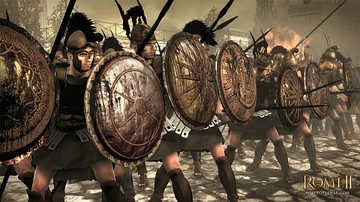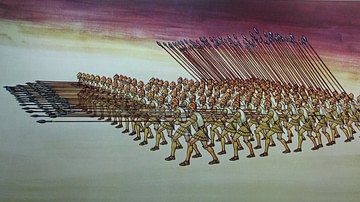
The Battle of Gaugamela (1st October 331 BCE, also known as the Battle of Arbela) was the final meeting between Alexander the Great of Macedon and King Darius III of Persia. After this victory, Alexander was, without question, the King of all Asia. Gaugamela (means "The Camel's House") was a village on the banks of the river Bumodus. The site of the battle is thought to be Tel Gomel (Hebrew - "Camels Mount") in northern Iraq.
Alexander's Campaign
Following the assassination of Phillip II, his father, in 336 BCE, Alexander and his army left their home of Macedonia for the last time and set out on a goal of conquering all of Persia. After crossing the Hellespont, Alexander traveled northward where he met and defeated the Persians under the leadership of the Greek mercenary Memnon at the Battle of River Granicus. As in future meetings with Alexander, Darius and his generals continually underestimated the abilities of the young Alexander. He was considered by many, even those in Greece, to be nothing more than an upstart.
From the River Granicus Alexander moved southward along the coast of Asia Minor to Halicarnassus where he defeated Memnon for the second time. Finally, after waiting for over a year, Alexander and his forces met Darius at Issus in November of 333 BCE where, again, the Persians suffered defeat. Even more embarrassing for Darius was that Alexander captured his family - his mother, wife, and daughters. Wishing to avoid further conflict (and hoping to regain his family), Darius offered Alexander half of his kingdom and even his daughter's hand in marriage; however, Alexander rejected the offer by simply saying there could never be two suns - it would upset the world order. Alexander also challenged the Persian king to face him again in battle.
From Issus Alexander moved along the Mediterranean coast, capturing the island city of Tyre in a seven-month siege. As he traveled southward, he was welcomed in both Jerusalem and Egypt, for they had felt the wrath of the Persian army and the pangs of religious oppression. After laying out the plans for the future city of Alexandria and visiting the temple at Siwa, Alexander prepared for his next engagement with Darius.
Battle Preparations
Alexander had planned to march straight to Babylon, but when he learned of Darius' presence at Gaugamela, he turned northward to meet the waiting Persian king. He realized a victory at Gaugamela meant all of Persia - Babylon, Persepolis, and Susa - would be his.
Darius, however, had learned his lesson at the Battle of Issus and had carefully chosen Gaugamela for his next, and hopefully last, battle against Alexander. This time his army was quite different, having brought together men from all over his empire, even Indian mercenaries - estimates of his army vary from 50,000 to 100,000 to almost a million. Along with 15 elephants (although they were never used), he had 200 scythed chariots. He fashioned longer swords and lances as well as adding more cavalry. The terrain of Gaugamela was also significant; it was much wider so he could make use of his chariots and deploy his cavalry more effectively, something that had been impossible at Issus. He had the ground leveled, placing obstacles and traps to impede the advances of Alexander's forces. To Darius it appeared the size of his army and the terrain gave him a significant advantage.

The night before battle Alexander held a council of his generals; Parmenio, the commander of Alexander's left flank, suggested that the large size of Darius's forces called for them to attack at night; however, Alexander disagreed. The historian Arrian made mention of this episode in his History of Alexander:
It is said that Parmenio came to him in his tent and urged him to make a night attack on the Persians, saying that thus he would fall upon them unprepared and in a state of confusion … but the reply which he made to him … was that it would mean to steal a victory …
Later, as Alexander addressed his men, he spoke of the forthcoming battle, reassuring the typically superstitious Macedonians that an earlier eclipse of the moon was a sign of victory.
Battle
On the day of the battle, Alexander is said to have overslept. As he had done previously, he made sure his men were well-fed and well-rested. Darius' men, on the other hand, had been awake all night fearing a night attack that never came. As Alexander looked across the battlefield towards the Persians, Alexander called out individual soldiers by name, speaking of their bravery in other battles and asking them to fight again for Macedonia. As he spoke an eagle (a favorite animal of Zeus) flew overhead and towards Darius. To Alexander, this was another omen of victory.

As in every other battle, Alexander and his companion cavalry took position on the right flank while Parmenio, as usual, held the left flank. Stationed in the middle were the well-trained Macedonian phalanx with more light infantry and archers on either side. Alexander also did something different; he chose to place infantry at angles on the ends of both the right and left flanks, to protect against a possible flanking maneuver by the Persians. He also placed additional Greek infantry to the rear of the center.
As the battle began, Alexander and his Companions immediately moved to the right at an oblique angle. Following Darius's orders, the Persians, under the leadership of Bessus, moved to their left, countering Alexander in an attempt to outflank him. As the Persians moved further and further to their left and into terrain that had not been cleared, an opening or gap was created. According to some historians, this entire move by Alexander had been a feint. Seeing the opening, Alexander formed his men into a wedge and quickly moved to his left and into the clearing, charging the shocked Darius.

Darius now seeing all was lost, that those who were placed in front of him were broken and beat back upon him, that he could not turn or disengage his chariot without great difficulty, the wheels being clogged and entangled among the dead bodies … was glad to quit his chariot and his arms, and mounting it is said, upon a mare that had been taken from her foal, betook himself to flight.
When the Persians on the left flank saw their king flee the battlefield, they quickly gave up the fight and were soon routed.











